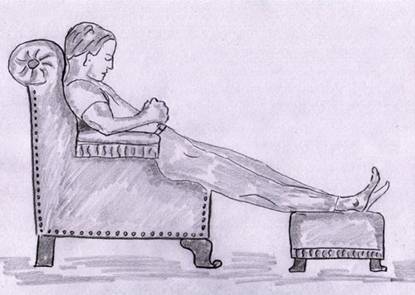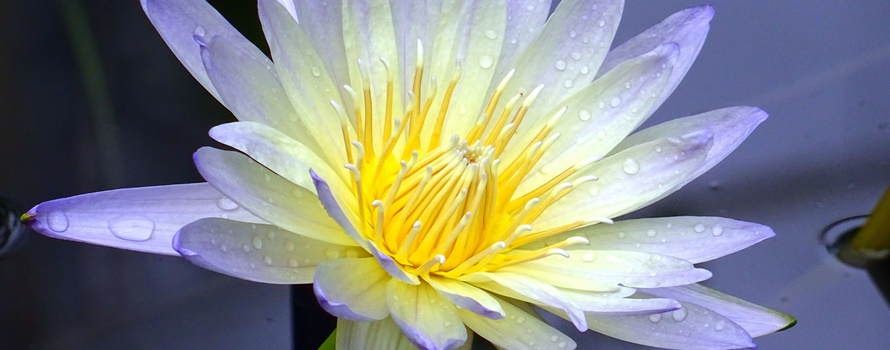Spiritual Immersion
Implementation of a Spiritual Immersion in Reclining Position
Description from the ebook “Eine ungewöhnliche Partnerschaft” (“An unusual relationship”) by A. Ballabene:
After inquiring about the ways of realizing a spiritual immersion, Erwin chose an easy and proven method. Everyday in the early morning he lay down on the floor. The hard ground reminded him that he was not lying in bed to relax and the gentle pressure helped him to stay concentrated. He used a folded blanket as a pillow so that his head would not hurt. He turned his head to one side. Otherwise the palate could close due to the relaxation of the mouth muscles. This would impede respiration.
Laying in this position, Erwin imagined that his arms and legs and finally his whole body become heavy as lead. Simultaneously, he listened into his body and tried to feel it. He sensed the surface of his skin and tried to get it warm. Then he tried to feel this bodily warmth. He imagined how the energy flows through his body and tried to feel it.
Due to consistent practice, Erwin was able to perform this exercise better and better. His consciousness was parting from the outside world and he intensified his inner perception. After a while he stopped with the sensing of his body and the observation of the energy currents. Instead he focused on the empty space inside of him. From this point on he wasn't regulating anymore, he was just observing. The only thing he was controlling was his intent to immerse deeper and deeper inside of himself and to observe the occurrences. Aside from that he was not interfering with the inner events. Interest, observation and calmness of mind kept him from falling asleep.
Erwin wasn't rushing the process of the deep relaxation out of impatience, like many others do. He was working slowly and diligent. From his work in the laboratory he knew that he had to work carefully and move forward with small steps, if he wanted a process to take place the desired way. Superficiality and skipping of important intermediate steps out of impatience often lead to frustrating failures. In this respect his job had trained him well.
Minor Help before Relaxation
Tense up and Relax:
We tense up all muscles and slightly curve our backs (by tensing up). With a deep exhale we fall back and relax. We do that several times if necessary. This enhances our body awareness so that the relaxation becomes easier.
Stretching of the Spine:
We stretch the heels forward and hook them into the floor. Then we try to pull our body with our feet (like an earthworm or a caterpillar). The shoulders stay in contact with the floor so that the moving feet stretch the body below the shoulders (spine).
As an additional help we stretch our arms above our head and try to have a good yawn.
Preliminary Exercise
We close our eyes and start with the first stage of relaxation by using the “tensing up and relaxing” technique as described previously. With our head inclined towards the side and a slightly opened mouth (otherwise the tongue slides back while relaxing and hinders respiration), we breathe deeply (abdominal breathing). We try to come into a deeper state of relaxation. While doing so, we can imagine how the relaxation becomes deeper with each breath. The breathing should flow naturally and must not be forced.
Body Position (abbreviated version):
- lie flat
- arms bend slightly
- hands relaxed
- fingers bend slightly
- eyes closed
- head inclined towards side
- mouth open slightly
- tongue relaxed
- breath passive and rhythmic
Checking:
Mentally, we try to check the body beginning from the toes upwards and look for tensions. If our limbs are uptight we shake them out to relief the tension. Eventually, we use the muscle contraction technique as discussed previously.
Listening Inwards:
When we feel relaxed, we concentrate our attention on the inside of our body. Step by step we go deeper inside:
- We observe the inhalation and exhalation – “Breathing in, breathing out”.
-
We feel the blood pulsating through our veins. Like that we perceive our whole body by taking small steps.
-
Intensively, we sense the feel of warmth and how it fills our body pleasantly.
- We try to think of nothing. Instead, we just are and perceive the body.
End of the Relaxation Exercise
After taking a deep breath we open up our eyes, tense up all muscles and the spine, clench our fists and fall back again (to vitalize the circulatory system). We can also stretch our arms above our head like we often do in the morning (yawn eventually). Once again we take a deep breath and slowly sit up (slowly because of the circulatory system).
Prevention of Falling Asleep
The spiritual immersion is a state of silence that comes close to sleeping, that's why many people struggle with falling asleep while practicing the immersion.
There are several tricks to prevent that:
- Fresh, oxygen-rich air has a vitalizing effect.
-
The chest should not be weighted so that the breathing is not being hindered.
-
Body position: The more upright we sit the better we stay awake. For me an inclination of 45 degree was ideal. Felicitas Goodman also recommends this position. It is one of the most important shamanic positions.

Inclined Position: This was my preferred position for the spiritual immersion. 30 to 45 degree are optimal.
Concentrating on a Specific Process to Prevent Falling Asleep (Gauri)
Often I prevent falling asleep by using a prayer chain and mentally reciting mantras. Therefore I move a pearl of the chain after every mantra or prayer. Only a minimal movement of two fingers is needed for that. The rest of the body is deeply relaxed and slowly falls into doze. My spirit stays awake.
If I concentrate only on one thought without the prayer chain, I can only keep up my concentration with a lot of effort. Combining the inner orientation with an outer process (moving the pearls of the prayer chain) prevents me from falling asleep. After a while I realize that I am floating over my physical body. Often I don't realize the separation process.
Relaxation in Seating Position – “Cabman's Posture”
This position requires a sitting posture (on a chair). Our back is straight and leans against the back of the chair (chest and stomach are clear and the breathing is unhindered). The feet are parallel and the hands rest on the lap. The head sinks down so that we don't hinder breath by the root of the tongue falling back (results in snoring). The eyes are closed, the muscles relaxed.

© Alfred Ballabene (Vienna) translated by Seth

